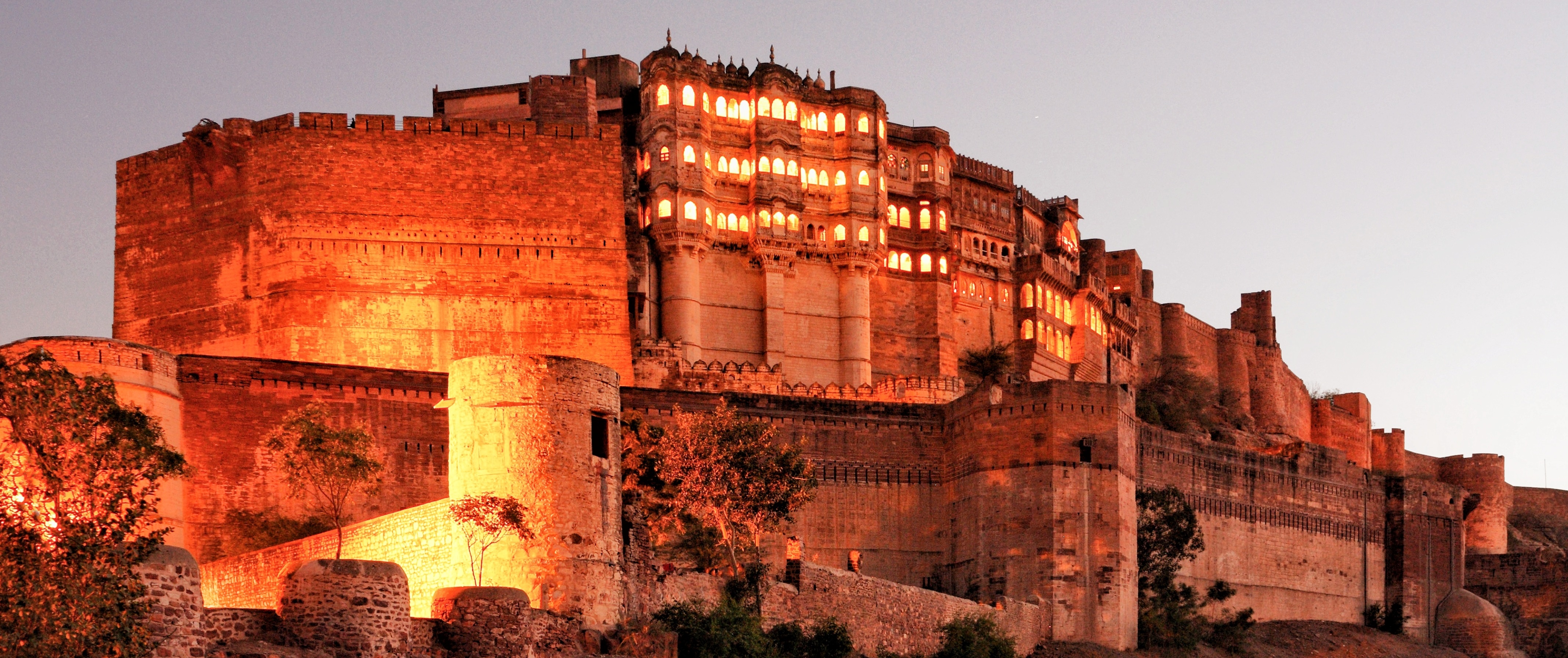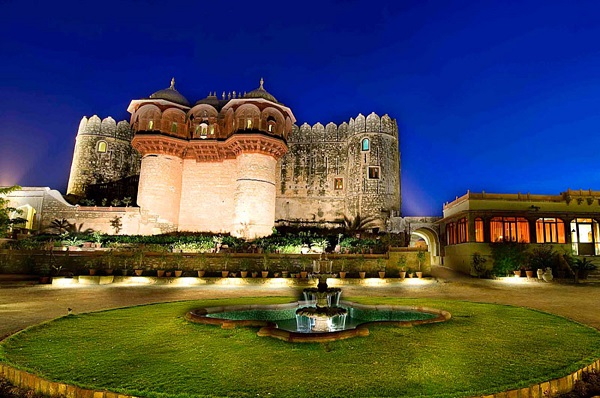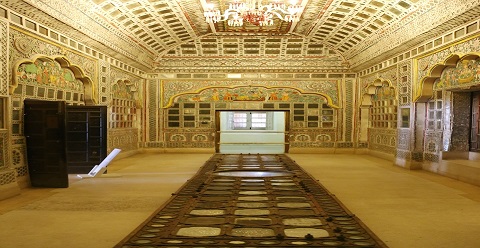
ABOUT THE VENUE
Lecture Hall Complex, is well designed facility for organizing conferences/seminars. The Complex houses the main auditorium and several halls for parallel sessions. The main auditorium and seminar halls are fully air-conditioned, with excellent stage visibility.
State-of-art projection and sound systems are in place. The complex is located on southern part of the campus, set in an serene atmosphere, ideal for scientific sessions. The lower foyer provides excellent office space and the upper foyer is suitable for exhibits and commercial stalls. parking space is also available.
ABOUT JODHPUR



Jodhpur, formerly known as Marwar, the capital of the Rajput rulers, has long history of various traditions which are followed till date.
Jodhpur, the second largest city in Rajasthan is popularly known as the Blue City. The name is clearly befitting as most of the architecture – forts, palaces, temples, havelis and even houses are built in vivid shades of blue. The strapping forts that tower this magnificent city sum up to a spectacle you would not want to miss. The mammoth, imposing fortress of Mehrangarh has a landscape dominating a rocky ridge with the eight gates leading out of the fortress. The new city is located outside the structure. Jodhpur is also known for the rare breed of horses known as Marwari or Malani, which are only found here.
Jodhpur marks its origin back to the year of 1459 AD. The history of this prosperous city revolves around the Rathore clan. Rao Jodha, the chief of Rathore Clan is credited with the origin of Jodhpur in India. The city is known to be built in place of the ancient capital, Mandore of the state of Manwar. Hence, the people of Jodhpur and surrounding areas are commonly known as Marwaris. Also, it is believed that the relics of Mandore can still be witnessed in the Mandore Gardens.
How to get there?
On the international circuit, Jodhpur is well connected to US, Canada, Europe, Middle East and South East Asia and all major international destinations by immediate connections through Mumbai, New Delhi, Kolkata, & Chennai. There are daily flights from Delhi and Mumbai to Jodhpur. Air India and Indigo operate the daily flight to each of these cities;
IIT Jodhpur is located on the outskirts of the city of Jodhpur and is well connected to other parts of country by road, rail and air. The Institute is located on National Highway 62 at Karwad Village, about 24 km from the railway station and 25 km from the airport; it takes approximately 45 mins and 40 mins to drive from airport and railway station to the Institute, respectively..
In and Around Jodhpur
Mehrangarh Fort: Rising perpendicular and impregnable from a hill which is 125 metres above Jodhpur’s skyline is the Mehrangarh Fort. This historic fort is one of the most famous in India and is packed with history and legends. Mehrangarh Fort still bears the imprints of cannonball attacks courtesy the armies of Jaipur on its second gate. Chiselled and sturdy, the fort is known for its exquisite latticed windows, carved panels, intricately decorated windows and walls of Moti Mahal, Phool Mahal and Sheesh Mahal.

Khejarala Fort: Located 60 kilometres from the main city, the 400-year old Khejarla Fort is situated in a rural setting. The stunning red sandstone monument, now a hotel, is an example of Rajput architecture. Visitors will be mesmerised by the fort’s picturesque settings, latticework friezes and intricate Jharokas.

Umaid Bhavan Palace: Umaid Bhawan Palace was built by Maharaja Umaid Singh in 1929 to counter a famine which had hit the state at the time. It was also known as the Chittar Palace while being constructed thanks to the use of stones drawn from the Chittar hill. The palace was designed by HV Lanchester, a renowned British architect, and was completed in 16 years. Built with sandstone and marble, the architecture of the palace is described as a blend of lndo-Saracenic, Classical Revival and Western Art Deco styles. It is recognised as one of the largest private homes in the world and also one of the more spectacular buildings. It is the only palace built in the 20th century.

Moti Bhavan: Moti Mahal, as the name suggests, is the Pearl Hall where the royal families held their audience. The hall is known to have glass windows and five nooks that enabled the queens to listen to the proceedings taking place in the Sringar Chowki, The Royal Throne of Jodhpur.

Sheesh Mahal: Situated within the compound of Mehrangarh Fort is the glass palace of Jodhpur, popularly known as Sheesh Mahal. This magnificent piece of architecture is adorned with walls of mirror work that stretch across ceilings and to the floors. It is superimposed by the mirror work of brightly painted religious figures cast in plaster.

Guda Village: Guda, a Bishnoi village, is home to a vivid range of exotic wildlife and nature. It is a habitat for thousands of migratory birds in the area. One can often catch the Demoiselle crane frolicking at the lake. Antelopes and black bucks can also be spotted by the pond. This place is a must-visit for nature lovers.

Things to do
Explore Mehrangarh Fort: Imposing Mehrangarh Fort, which rises above the “Blue City,” is one of the largest and most famous forts. As impressive as it is, as a well-preserved heritage structure, there’s so much more to discover inside. The fort has been privately restored, and its museum has an outstanding display of royal memorabilia, including about 15,000 items from Maharaja Gaj Singh II’s collection. It also has the only professional museum shop in India.
Relax in Jaswant Thada : In honor of Maharaja Jaswant Singh II, this intricately crafted cenotaph (empty commemorative tomb) was built in 1899. It features white marble lattice screens and whimsical domes, while the inside is adorned with portraits of Rathore rulers. It’s a peaceful place to relax and enjoy stunning views of the Fort and city.
Wander through Rao Jodha Desert Rock Park : The Rao Jodha Desert Rock Park was developed in 2006 to restore the natural ecology of a large rocky wasteland area next to the Fort. Neglected for many years, the park was overrun by an invasive thorny shrub. After the bush was eradicated, more than 80 native species of rock-loving plants from the Thar desert were grown there. The Park extends 70 hectares (around 200 acres) of rehabilitated land and has a walking trail. It’s interesting to explore at different times of the year, as its foliage changes with the seasons.
Checkout the Clock Tower and Old City Markets : A trip to Jodhpur wouldn’t be complete without visiting the bustling Old City. Many people choose to stay in this area, too, as some of the best budget hotels in Jodhpur are located there and have fabulous Fort views. The Old City’s famous landmark, the clock tower, stands at the heart of it—and it’s still working! Next to it, Sadar Market retains a traditional village bazaar feel. It’s chaotic and colorful and sells almost everything, including handicrafts, spices, saris, and fabric. If you feel uncomfortable in crowds, you might prefer to take a walking tour rather than explore the market area yourself, as the congestion can be overwhelming.
Dine Overlooking the Step Well : An exciting Urban Regeneration Project is being undertaken to transform the Old City into its former glory, but with a vibrant and hip spin. As a result, Jodhpur has a newly restored yet ancient stepwell, located just north of the clock tower. Built in the 1740s and called Toorji ka Jhalra, it sat stagnant for years until the owners of the new heritage boutique RAAS hotel purified the pool and sandblasted the steps. The area has been turned into a contemporary square with cool cafes and shops, including a Good Earth home decor store and a branch of Jaipur-based Gem Palace. A secret door at the RAAS hotel will take you directly to Step Well Square.
Excursions
Mount-Abu (253 Kms) : Mount Abu town, the only hill station in Rajasthan, is at an elevation of 1,220 m (4,003 ft). It has been a popular retreat from the heat of Rajasthan and neighboring Gujarat for centuries.
Kumbhalgarh (185 Kms) : Built on a hilltop 1,100 m (3,600 ft) above sea level on the Aravalli range, the fort of Kumbhalgarh has perimeter walls that extend 36 km (22 mi), making it among the longest walls in the world. The frontal walls are fifteen feet thick. Kumbhalgarh has seven fortified gateways.
Udaipur (270 Kms) : Udaipur with its lakes lies on the south slope of the Aravalli Range in Rajasthan. The northern part of the district consists generally of elevated plateaus, while the eastern part has vast stretches of fertile plains. The southern part is covered with rocks, Hills and dense Forest. The lakes of the city being interconnected form a lake system which supports and sustains the groundwater recharge, water availability for drinking, agriculture, industries and is a source of employment through tourism.
Jaipur (338 Kms) : Jaipur is a major tourist destination in India forming a part of the Golden Triangle. In the 2008 Conde Nast Traveller Readers Choice Survey, Jaipur was ranked the 7th best place to visit in Asia.
